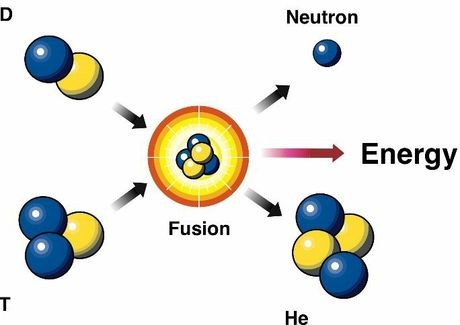Compare and contrast fission with fusion to understand the core differences between these two nuclear processes. At COMPARE.EDU.VN, we break down these concepts, offering clear explanations and relevant examples to help you grasp their distinct characteristics, including their impact on energy production. Discover the essentials of nuclear reactions!
Table of Contents:
- What is Nuclear Fission?
- What is Nuclear Fusion?
- Fission vs. Fusion: Key Differences
- The Future of Fission and Fusion
- Real-World Applications and Examples
- Advantages of Fission and Fusion
- Disadvantages of Fission and Fusion
- How Fission and Fusion Impact the Future of Energy
- Expert Insights on Fission and Fusion
- Fission and Fusion: Addressing Common Misconceptions
- Comparing Fission and Fusion: A Detailed Table
- The Role of COMPARE.EDU.VN in Understanding Nuclear Processes
- FAQs About Fission and Fusion
1. What is Nuclear Fission?
Nuclear fission is a process where the nucleus of an atom splits into two or more smaller nuclei. This splitting process releases a significant amount of energy, which can be harnessed for various applications, including power generation.
The Fission Process Explained
Fission typically begins when a heavy nucleus, such as uranium-235, is struck by a neutron. This causes the nucleus to become unstable and split apart. The fission process releases not only energy but also additional neutrons. These neutrons can then strike other nuclei, causing them to fission as well, leading to a chain reaction. According to research from the Department of Nuclear Engineering at MIT, controlling these chain reactions is crucial for safe and efficient energy production.
Nuclear Fission Examples
- Nuclear Power Plants: Fission is used in nuclear power plants to generate electricity. The heat produced from fission is used to boil water, creating steam that drives turbines connected to generators.
- Nuclear Weapons: Fission is also used in nuclear weapons, where an uncontrolled chain reaction releases an enormous amount of energy in a short period.
Advantages and Disadvantages of Nuclear Fission
Advantages:
- High Energy Output: Fission produces a large amount of energy from a small amount of fuel.
- Reliable Energy Source: Unlike renewable energy sources like solar and wind, nuclear power plants can operate continuously.
Disadvantages:
- Radioactive Waste: Fission produces radioactive waste, which requires long-term storage and disposal.
- Risk of Accidents: Nuclear accidents, such as Chernobyl and Fukushima, can release harmful radiation into the environment.
2. What is Nuclear Fusion?
Nuclear fusion is a process where two or more atomic nuclei combine to form a single, heavier nucleus. This process also releases a significant amount of energy and is the same process that powers the sun and other stars.
The Fusion Process Explained
Fusion occurs when two light nuclei, such as hydrogen isotopes (deuterium and tritium), are forced together under extreme temperatures and pressures. These conditions cause the nuclei to overcome their electrostatic repulsion and fuse together, releasing a large amount of energy.
Nuclear Fusion Examples
- The Sun: The sun is a natural fusion reactor, where hydrogen nuclei fuse to form helium, releasing vast amounts of energy in the process.
- Experimental Fusion Reactors: Scientists are working to develop fusion reactors on Earth, such as the ITER project, which aims to demonstrate the feasibility of fusion power.
Advantages and Disadvantages of Nuclear Fusion
Advantages:
- Abundant Fuel: Fusion uses hydrogen isotopes, which are abundant and can be extracted from seawater.
- Low Radioactive Waste: Fusion produces less radioactive waste compared to fission, and the waste products are generally shorter-lived.
Disadvantages:
- Extreme Conditions: Fusion requires extremely high temperatures and pressures, which are difficult and expensive to achieve and maintain.
- Technological Challenges: Fusion technology is still in the experimental stage, and there are significant technological challenges to overcome before it can become a practical energy source.
3. Fission vs. Fusion: Key Differences
Fission and fusion are both nuclear reactions that release energy, but they differ significantly in their processes, fuel sources, waste products, and applications.
Energy Release Comparison
- Fission: Releases energy when a heavy nucleus splits.
- Fusion: Releases energy when light nuclei combine.
Fusion generally releases more energy per reaction than fission. For example, the fusion of deuterium and tritium releases several times more energy than the fission of uranium-235.
Radioactive Waste Comparison
- Fission: Produces significant amounts of long-lived radioactive waste.
- Fusion: Produces less radioactive waste, and the waste products are generally shorter-lived.
The management and disposal of radioactive waste from fission are major challenges, while fusion offers a cleaner alternative in this regard.
Fuel Source Comparison
- Fission: Uses heavy elements like uranium and plutonium, which are finite resources.
- Fusion: Uses hydrogen isotopes, which are abundant and can be extracted from seawater.
The abundance of hydrogen isotopes makes fusion a more sustainable energy source compared to fission.
Controllability Comparison
- Fission: Chain reactions can be controlled in nuclear reactors.
- Fusion: Requires extreme conditions that are difficult to maintain and control.
Fission technology is well-established and controllable, while fusion is still in the experimental stage and faces significant challenges in achieving stable and sustained reactions.
Practical Applications Comparison
- Fission: Used in nuclear power plants and nuclear weapons.
- Fusion: Primarily in experimental reactors, with potential for future power generation.
Fission is currently used for power generation, while fusion holds promise for future energy production but is not yet commercially viable.
4. The Future of Fission and Fusion
Both fission and fusion have the potential to play significant roles in the future of energy, but they face different challenges and opportunities.
Advancements in Fission Technology
Advancements in fission technology are focused on improving safety, reducing waste, and increasing efficiency. This includes the development of advanced reactor designs, such as small modular reactors (SMRs) and Generation IV reactors, which offer enhanced safety features and reduced waste production.
Progress in Fusion Research
Fusion research is focused on overcoming the technological challenges of achieving and sustaining fusion reactions. Projects like ITER and other experimental reactors aim to demonstrate the feasibility of fusion power and pave the way for future commercial fusion reactors.
Potential for Clean Energy
Both fission and fusion offer the potential for clean energy production, with reduced greenhouse gas emissions compared to fossil fuels. Fission can provide a reliable and continuous source of energy, while fusion promises a more sustainable and environmentally friendly alternative in the long term.
5. Real-World Applications and Examples
To fully grasp the differences and potential of fission and fusion, let’s explore some real-world applications and examples.
Nuclear Power Plants: Fission in Action
Nuclear power plants around the world utilize fission to generate electricity. In a typical nuclear reactor, uranium-235 nuclei are bombarded with neutrons, causing them to split and release energy. This energy heats water, producing steam that drives turbines connected to generators.
The Sun: Nature’s Fusion Reactor
The sun is a massive fusion reactor, where hydrogen nuclei fuse to form helium, releasing vast amounts of energy in the process. This energy sustains life on Earth and provides a natural example of the potential of fusion power.
Nuclear Weapons: Fission and Fusion in Military Applications
Nuclear weapons utilize both fission and fusion to create devastating explosions. Fission bombs, like the ones used in World War II, rely on uncontrolled chain reactions to release energy. Hydrogen bombs, on the other hand, use fission to trigger a fusion reaction, resulting in an even more powerful explosion.
Medical Isotopes: Fission’s Role in Healthcare
Fission is also used to produce medical isotopes, which are used in diagnostic imaging and cancer treatment. These isotopes are created by bombarding target materials with neutrons in nuclear reactors.
Fusion Energy Research: Striving for Sustainable Power
Scientists around the world are working to develop fusion reactors that can provide a sustainable and environmentally friendly source of energy. Projects like ITER aim to demonstrate the feasibility of fusion power and pave the way for future commercial fusion reactors.
6. Advantages of Fission and Fusion
Both fission and fusion offer several advantages as potential energy sources.
High Energy Output
Both fission and fusion produce a large amount of energy from a small amount of fuel. This high energy output makes them attractive alternatives to fossil fuels, which require large quantities of fuel to generate the same amount of energy.
Reliable Energy Source
Nuclear power plants that use fission can operate continuously, providing a reliable source of energy. This is in contrast to renewable energy sources like solar and wind, which are intermittent and depend on weather conditions.
Reduced Greenhouse Gas Emissions
Both fission and fusion produce little to no greenhouse gas emissions during operation. This makes them important tools in the fight against climate change, as they can help reduce our reliance on fossil fuels and lower carbon emissions.
Fuel Availability
While uranium, the fuel used in fission reactors, is a finite resource, it is relatively abundant and widely distributed. Fusion, on the other hand, uses hydrogen isotopes, which are virtually limitless and can be extracted from seawater.
Technological Advancements
Both fission and fusion technologies are constantly evolving, with ongoing research and development efforts aimed at improving safety, efficiency, and sustainability. These advancements could lead to even greater benefits in the future.
7. Disadvantages of Fission and Fusion
Despite their advantages, both fission and fusion also have several disadvantages that must be addressed.
Radioactive Waste
Fission produces radioactive waste, which requires long-term storage and disposal. This waste can remain radioactive for thousands of years, posing a potential risk to human health and the environment.
Nuclear Accidents
Nuclear accidents, such as Chernobyl and Fukushima, can release harmful radiation into the environment, causing widespread contamination and long-term health effects. These accidents highlight the importance of safety measures and regulations in the nuclear industry.
High Costs
Nuclear power plants are expensive to build and maintain, requiring significant upfront investment and ongoing operating costs. Fusion reactors are even more expensive, with experimental projects like ITER costing billions of dollars.
Technical Complexities
Both fission and fusion technologies are technically complex, requiring highly skilled personnel and advanced engineering solutions. This complexity can make it difficult to develop and deploy these technologies on a large scale.
Proliferation Risks
Fission technology can be used to produce nuclear weapons, posing a proliferation risk. This risk is mitigated by international safeguards and regulations, but it remains a concern.
8. How Fission and Fusion Impact the Future of Energy
Fission and fusion have the potential to play significant roles in the future of energy, helping to address some of the world’s most pressing challenges.
Addressing Climate Change
By providing a low-carbon alternative to fossil fuels, fission and fusion can help reduce greenhouse gas emissions and mitigate the effects of climate change.
Energy Security
Nuclear power can enhance energy security by reducing our reliance on imported fossil fuels and diversifying our energy sources.
Technological Innovation
Investment in nuclear technologies can drive innovation in materials science, engineering, and other fields, leading to broader economic benefits.
Economic Growth
The development and deployment of nuclear technologies can create jobs and stimulate economic growth in the energy sector and related industries.
Global Collaboration
Addressing the challenges and opportunities of nuclear energy requires global collaboration and cooperation, fostering international partnerships and knowledge sharing.
9. Expert Insights on Fission and Fusion
To provide a comprehensive understanding of fission and fusion, let’s consider some expert insights on these technologies.
Quotes from Leading Scientists
- “Fusion is not 30 years away, it’s always been 30 years away.” – A humorous but poignant reflection on the challenges of fusion research.
- “Nuclear fission has provided a reliable source of energy for decades, but we must continue to improve safety and reduce waste.” – A call for responsible development of fission technology.
Perspectives from Industry Professionals
- “The nuclear industry is committed to innovation and safety, working to develop advanced reactor designs and improve waste management practices.” – A commitment to responsible nuclear energy development.
- “Fusion energy has the potential to transform the world’s energy landscape, but it requires sustained investment and collaboration.” – A vision for the future of fusion power.
Analysis from Policy Makers
- “Nuclear energy plays a critical role in our efforts to reduce carbon emissions and ensure a secure energy future.” – A recognition of the importance of nuclear energy in climate policy.
- “We must support research and development of both fission and fusion technologies to diversify our energy sources and address the challenges of climate change.” – A call for investment in nuclear energy innovation.
10. Fission and Fusion: Addressing Common Misconceptions
There are several common misconceptions about fission and fusion that need to be addressed to promote a more informed understanding of these technologies.
Misconception 1: Fission and Fusion are the Same
Fission and fusion are often confused, but they are fundamentally different processes. Fission involves splitting a heavy nucleus, while fusion involves combining light nuclei.
Misconception 2: Nuclear Energy is Unsafe
While nuclear accidents can occur, nuclear power plants are generally safe and heavily regulated. Advances in reactor design and safety measures have significantly reduced the risk of accidents.
Misconception 3: Fusion is Just Around the Corner
Fusion is still in the experimental stage, and there are significant technological challenges to overcome before it can become a practical energy source. While progress is being made, it is unlikely that fusion power will be widely available in the near future.
Misconception 4: Nuclear Waste is Unmanageable
Nuclear waste is a challenge, but it can be safely managed through various storage and disposal methods. Ongoing research is also exploring ways to reduce the amount and radioactivity of nuclear waste.
Misconception 5: Renewable Energy Alone Can Solve Our Energy Needs
Renewable energy sources like solar and wind are important, but they are intermittent and cannot provide a continuous source of energy. Nuclear energy can complement renewable energy by providing a reliable baseload power supply.
11. Comparing Fission and Fusion: A Detailed Table
| Feature | Fission | Fusion |
|---|---|---|
| Process | Splitting of a heavy nucleus | Combining of light nuclei |
| Fuel | Uranium, Plutonium | Hydrogen isotopes (Deuterium, Tritium) |
| Energy Release | High | Higher |
| Waste Products | Long-lived radioactive waste | Less radioactive waste, shorter-lived |
| Availability | Currently used in nuclear power plants | Experimental, not yet commercially viable |
| Controllability | Controllable chain reaction | Difficult to control |
| Fuel Source | Finite | Virtually limitless |
| Safety | Risk of nuclear accidents | Lower risk of accidents |
| Cost | High initial cost | Very high initial cost |
| Applications | Power generation, nuclear weapons, medical isotopes | Future power generation |



12. The Role of COMPARE.EDU.VN in Understanding Nuclear Processes
COMPARE.EDU.VN is dedicated to providing clear, comprehensive, and unbiased comparisons of complex topics like nuclear fission and fusion. Our goal is to empower you with the knowledge you need to make informed decisions and understand the world around you. Visit COMPARE.EDU.VN to explore more comparisons and deepen your understanding of various subjects.
If you’re struggling to make sense of complex topics and need help comparing different options, turn to COMPARE.EDU.VN. Our detailed comparisons, expert insights, and user-friendly format make it easy to understand even the most challenging subjects. Whether you’re comparing energy sources, technologies, or scientific concepts, COMPARE.EDU.VN is your go-to resource for clear and reliable information.
Ready to dive deeper? Explore more comparisons and make informed decisions at COMPARE.EDU.VN today.
13. FAQs About Fission and Fusion
Q1: What is the main difference between nuclear fission and nuclear fusion?
A1: Nuclear fission involves splitting a heavy atomic nucleus into smaller parts, releasing energy. Nuclear fusion, on the other hand, involves combining two light atomic nuclei to form a heavier nucleus, also releasing energy.
Q2: Which process, fission or fusion, produces more energy?
A2: Fusion generally releases more energy per unit of mass than fission. This is why the sun, powered by fusion, can produce such immense amounts of energy.
Q3: What are the fuel sources for fission and fusion?
A3: Fission typically uses heavy elements like uranium-235 and plutonium-239 as fuel. Fusion uses light elements, typically isotopes of hydrogen like deuterium and tritium.
Q4: Is nuclear fusion currently used to generate electricity?
A4: No, nuclear fusion is still in the experimental phase. Scientists are working to develop fusion reactors, but there are significant technological challenges to overcome before fusion can be used to generate electricity commercially.
Q5: What are the advantages of fusion over fission?
A5: Fusion has several potential advantages over fission, including a virtually limitless fuel supply (hydrogen isotopes from seawater), the production of less radioactive waste, and a lower risk of nuclear accidents.
Q6: What are the main challenges of achieving practical nuclear fusion?
A6: The main challenges include achieving and maintaining the extremely high temperatures and pressures required for fusion to occur, as well as developing materials that can withstand these extreme conditions.
Q7: Does nuclear fission produce radioactive waste?
A7: Yes, nuclear fission produces radioactive waste, which requires careful management and long-term storage due to the long half-lives of some of the waste products.
Q8: Are nuclear power plants based on fission safe?
A8: Nuclear power plants have safety measures in place, but accidents can occur, as seen in Chernobyl and Fukushima. Modern reactor designs incorporate enhanced safety features to reduce the risk of accidents.
Q9: How does COMPARE.EDU.VN help in understanding these complex processes?
A9: COMPARE.EDU.VN provides detailed comparisons, expert insights, and user-friendly explanations to help readers understand complex topics like nuclear fission and fusion.
Q10: Where can I find more information about nuclear energy and related topics?
A10: You can find more information on COMPARE.EDU.VN, which offers a wide range of comparisons and educational content on various subjects.
Ready to make informed decisions? Explore more comparisons and expert insights at compare.edu.vn today! Contact us at 333 Comparison Plaza, Choice City, CA 90210, United States or Whatsapp: +1 (626) 555-9090.

